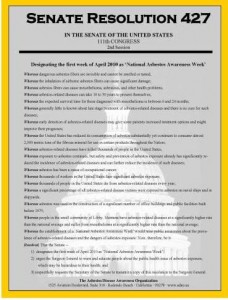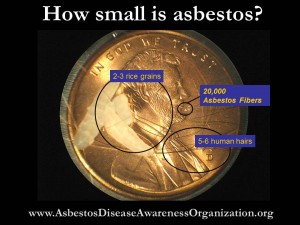Posted on April 1, 2010
Top 10 Reasons to Prevent Asbestos Exposure
April 1st
By Linda Reinstein
ADAO President/CEO and Co-Founder
Since 2004, the Asbestos Disease Awareness Organization has given asbestos victims and concerned citizens a united voice to raise public awareness about the threat that asbestos exposure poses to public health. Now 6,000 strong, ADAO is the largest international organization dedicated to preventing asbestos-related diseases through education and legislation. Every day during National Asbestos Awareness Week (April 1 – 7, 2010), ADAO will empower the public with information on asbestos and its commercial use; how to prevent exposure in homes, schools, and in workplaces; early warning symptoms and medical treatment options; and clarify that asbestos is not a banned product in the United States and is still be using in common household products. *Linda Reinstein co-founded ADAO in 2004. ADAO’s mission includes supporting global advocacy and advancing asbestos awareness, prevention, early detection, treatment, and resources for asbestos-related disease. She will present at ADAO’s 6th International Asbestos Awareness Conference on April 10th. *Linda Reinstein co-founded ADAO in 2004. ADAO’s mission includes supporting global advocacy and advancing asbestos awareness, prevention, early detection, treatment, and resources for asbestos-related disease. She will present at ADAO’s 6th International Asbestos Awareness Conference on April 10th. |
 Top 10 Reasons to Prevent Asbestos Exposure
Top 10 Reasons to Prevent Asbestos Exposure
1. Asbestos is a known human carcinogen.
2. The United States and Canada are the last two industrial nations not to ban asbestos. More than 50 countries have banned asbestos as of January 2010.
3. The Word Health Organization (WHO) indicates that there are approximately 125 million people in the world who are exposed to asbestos in the workplace.
4. More than 10,000 Americans die each year from exposure to asbestos and the number is rising. It is projected that in the next decade asbestos diseases will kill at least 100,000 Americans alone.
5. Once airborne, microscopic asbestos fibers can be carried hundreds of miles away from its source.
6. Inhaling or swallowing asbestos fibers can cause permanent and irreversible damage to vital organs. Asbestos fibers can cause asbestosis, lung and gastrointestinal cancers, and an aggressive cancer called mesothelioma. Mesothelioma patients’ average life expectancy is six – twelve months.
7. Asbestos remains a consumer threat today. ADAO’s 2007 Product Testing Report revealed 5 products were contaminated with asbestos, including a child’s toy.
8. Asbestos diseases have a long latency period from initial exposure to development of disease from 50 years or longer; are difficult to diagnose as it mimics other ailments; difficult to treat, often incurable and frequently deadly.
9. The World Health Organization (WHO), International Labor Organization (ILO), Environmental Protection Agency (EPA), and the Acting U.S. Surgeon General state that there is no safe level of exposure to asbestos.
10. Asbestos has been mined and used in a broad range of products, materials, and applications including but not exclusive to construction, insulation, shipyards, and many other industries.
Advocacy
 For the past six years, ADAO has worked with the U. S. Senate to pass legislation to increase public awareness about asbestos, a known human carcinogen. This year, ADAO praises the Senate for passing S.RES.427, declaring the first week of April as “National Asbestos Awareness Week.” In 2009, as a result of the passage of National Asbestos Awareness Week, the Surgeon General issued a statement warning and educating Americans of the severe hazards of asbestos exposure.
For the past six years, ADAO has worked with the U. S. Senate to pass legislation to increase public awareness about asbestos, a known human carcinogen. This year, ADAO praises the Senate for passing S.RES.427, declaring the first week of April as “National Asbestos Awareness Week.” In 2009, as a result of the passage of National Asbestos Awareness Week, the Surgeon General issued a statement warning and educating Americans of the severe hazards of asbestos exposure.
Asbestos Awareness Week Contributors:
April 1st Linda Reinstein, President/CEO, Asbestos Disease Awareness Organization (ADAO)
April 3rd Ken Cook, President, Environmental Working Group (EWG)
April 6th Paul Zygielbaum, ADAO Product Testing Manager and Laurie Kazan-Allen, IBAS

 Top 10 Reasons to Prevent Asbestos Exposure
Top 10 Reasons to Prevent Asbestos Exposure